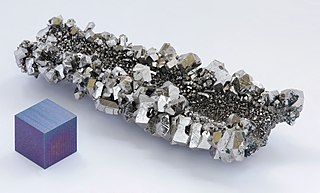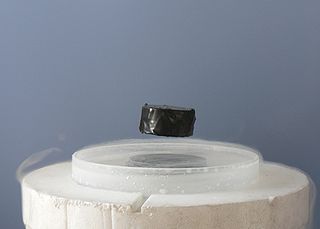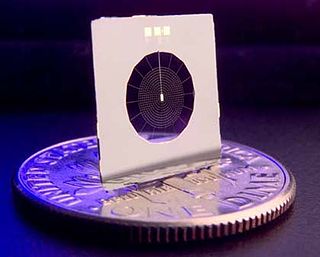
Niobium is a chemical element with chemical symbol Nb and atomic number 41. It is a light grey, crystalline, and ductile transition metal. Pure niobium has a Mohs hardness rating similar to pure titanium, and it has similar ductility to iron. Niobium oxidizes in Earth's atmosphere very slowly, hence its application in jewelry as a hypoallergenic alternative to nickel. Niobium is often found in the minerals pyrochlore and columbite, hence the former name "columbium". Its name comes from Greek mythology: Niobe, daughter of Tantalus, the namesake of tantalum. The name reflects the great similarity between the two elements in their physical and chemical properties, which makes them difficult to distinguish.

Superconductivity is a set of physical properties observed in certain materials where electrical resistance vanishes and magnetic flux fields are expelled from the material. Any material exhibiting these properties is a superconductor. Unlike an ordinary metallic conductor, whose resistance decreases gradually as its temperature is lowered, even down to near absolute zero, a superconductor has a characteristic critical temperature below which the resistance drops abruptly to zero. An electric current through a loop of superconducting wire can persist indefinitely with no power source.

A bolometer is a device for measuring radiant heat by means of a material having a temperature-dependent electrical resistance. It was invented in 1878 by the American astronomer Samuel Pierpont Langley.

Photodetectors, also called photosensors, are sensors of light or other electromagnetic radiation. There is a wide variety of photodetectors which may be classified by mechanism of detection, such as photoelectric or photochemical effects, or by various performance metrics, such as spectral response. Semiconductor-based photodetectors typically photo detector have a p–n junction that converts light photons into current. The absorbed photons make electron–hole pairs in the depletion region. Photodiodes and photo transistors are a few examples of photo detectors. Solar cells convert some of the light energy absorbed into electrical energy.

Superconductivity is the phenomenon of certain materials exhibiting zero electrical resistance and the expulsion of magnetic fields below a characteristic temperature. The history of superconductivity began with Dutch physicist Heike Kamerlingh Onnes's discovery of superconductivity in mercury in 1911. Since then, many other superconducting materials have been discovered and the theory of superconductivity has been developed. These subjects remain active areas of study in the field of condensed matter physics.

Indium nitride is a small bandgap semiconductor material which has potential application in solar cells and high speed electronics.

Hg1−xCdxTe or mercury cadmium telluride is a chemical compound of cadmium telluride (CdTe) and mercury telluride (HgTe) with a tunable bandgap spanning the shortwave infrared to the very long wave infrared regions. The amount of cadmium (Cd) in the alloy can be chosen so as to tune the optical absorption of the material to the desired infrared wavelength. CdTe is a semiconductor with a bandgap of approximately 1.5 electronvolts (eV) at room temperature. HgTe is a semimetal, which means that its bandgap energy is zero. Mixing these two substances allows one to obtain any bandgap between 0 and 1.5 eV.
Cryogenic particle detectors operate at very low temperature, typically only a few degrees above absolute zero. These sensors interact with an energetic elementary particle and deliver a signal that can be related to the type of particle and the nature of the interaction. While many types of particle detectors might be operated with improved performance at cryogenic temperatures, this term generally refers to types that take advantage of special effects or properties occurring only at low temperature.

Tantalum nitride (TaN) is a chemical compound, a nitride of tantalum. There are multiple phases of compounds, stoichimetrically from Ta2N to Ta3N5, including TaN.

Andreev reflection (AR), named after the Russian physicist Alexander F. Andreev, is a type of particle scattering which occurs at interfaces between a superconductor (S) and a normal state material (N). It is a charge-transfer process by which normal current in N is converted to supercurrent in S. Each Andreev reflection transfers a charge 2e across the interface, avoiding the forbidden single-particle transmission within the superconducting energy gap.
A Josephson junction is a quantum mechanical device which is made of two superconducting electrodes separated by a barrier. A π Josephson junction is a Josephson junction in which the Josephson phase φ equals π in the ground state, i.e. when no external current or magnetic field is applied.

Superconducting wires are electrical wires made of superconductive material. When cooled below their transition temperatures, they have zero electrical resistance. Most commonly, conventional superconductors such as niobium-titanium are used, but high-temperature superconductors such as YBCO are entering the market.
The superconducting tunnel junction (STJ) — also known as a superconductor–insulator–superconductor tunnel junction (SIS) — is an electronic device consisting of two superconductors separated by a very thin layer of insulating material. Current passes through the junction via the process of quantum tunneling. The STJ is a type of Josephson junction, though not all the properties of the STJ are described by the Josephson effect.

A transition-edge sensor (TES) is a type of cryogenic energy sensor or cryogenic particle detector that exploits the strongly temperature-dependent resistance of the superconducting phase transition.

The kinetic inductance detector (KID) — also known as a microwave kinetic inductance detector (MKID) — is a type of superconducting photon detector first developed by scientists at the California Institute of Technology and the Jet Propulsion Laboratory in 2003. These devices operate at cryogenic temperatures, typically below 1 kelvin. They are being developed for high-sensitivity astronomical detection for frequencies ranging from the far-infrared to X-rays.

The superconducting nanowire single-photon detector is a type of optical and near-infrared single-photon detector based on a current-biased superconducting nanowire. It was first developed by scientists at Moscow State Pedagogical University and at the University of Rochester in 2001. The first fully operational prototype was demonstrated in 2005 by the National Institute of Standards and Technology (Boulder), and BBN Technologies as part of the DARPA Quantum Network.

Niobium diselenide or niobium(IV) selenide is a layered transition metal dichalcogenide with formula NbSe2. Niobium diselenide is a lubricant, and a superconductor at temperatures below 7.2 K that exhibit a charge density wave (CDW). NbSe2 crystallizes in several related forms, and can be mechanically exfoliated into monatomic layers, similar to other transition metal dichalcogenide monolayers. Monolayer NbSe2 exhibits very different properties from the bulk material, such as of Ising superconductivity, quantum metallic state, and strong enhancement of the CDW.
John Kenneth Hulm was a British-American physicist and engineer, known for the development of superconducting materials with applications to high-field superconducting magnets. In 1953 with George F. Hardy he discovered the first A-15 superconducting alloy.
A Josephson diode is an electronic device that superconducts electrical current in one direction and is resistive in the other direction. The device is a Josephson junction exhibiting a superconducting diode effect (SDE). It is an example of a quantum material Josephson junction (QMJJ), where the weak link in the junction is a quantum material.














